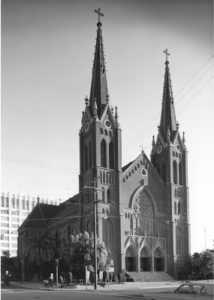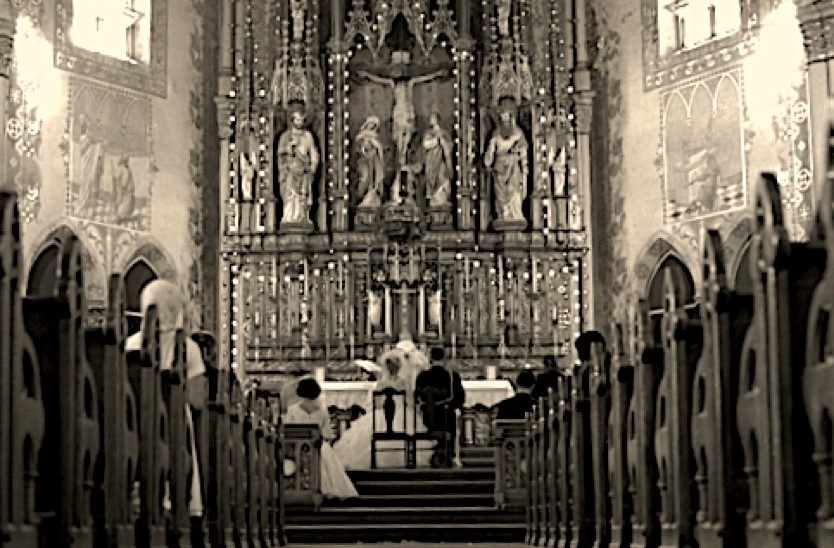 Many years ago, I saw the movie True Confessions (1981), which was about an ambitious priest who discovered the truer meaning of the priesthood. Although the film was seedy in places, the outcome for the main character, Monsignor Spellacy, was salutary.
Many years ago, I saw the movie True Confessions (1981), which was about an ambitious priest who discovered the truer meaning of the priesthood. Although the film was seedy in places, the outcome for the main character, Monsignor Spellacy, was salutary.
Robert DeNiro (who was more discreet and refined in those days) starred as Msgr. Spellacy. It was well acted, but it was the liturgical scenes that were especially noteworthy: they were beautiful, meticulous, and accurate. The movie was set in the 1940s and so the older Latin Mass was depicted in all its solemn, high glory (see the movie clip at the end of the post).
The church itself was gorgeous as well. Over the years I could never identify the church, despite asking many people. No one seemed to know. The movie credits made no mention of the parish where the Mass scenes were filmed. Even people I knew from the Los Angeles area (where the move was filmed) did not recognize the church. This was well before the Internet was in common use, so there was not the ability to pose a question far and wide. Until a few months ago, there just seemed to be no information available.
Mystery Solved – I finally stumbled upon the answer, completely by accident, about a month ago when I read about a fire that had destroyed St. Joseph Church in downtown Los Angeles in 1983.
 The article mentioned that St. Joseph had been seen in several TV shows and movies, including True Confessions. The cause was said to have been an electrical fire. The roof collapsed, and only the towers and some of the brick walls remained. What a loss! A smaller, modern church was subsequently built on the site to replace the older one.
The article mentioned that St. Joseph had been seen in several TV shows and movies, including True Confessions. The cause was said to have been an electrical fire. The roof collapsed, and only the towers and some of the brick walls remained. What a loss! A smaller, modern church was subsequently built on the site to replace the older one.
The exterior of the old St. Joseph Church is seen above. It was a truly magnificent German Gothic structure. Its interior is seen in the photo on the left, from 1960.
The following description of its beautiful interior was made upon its opening in 1903:
In the vast interiors of the great church … one may discover a wondrous work of gilt, and the deep tones of reds, greens, blues and yellows assembled with an artist’s touch into a magnificent whole.
This extensive fresco work [is] said to be the finest on the Coast. … For almost three months these men have toiled on the extensive work at St. Joseph’s sometimes far into the night…. … [I]t is said there will be no finer church edifice on the Pacific Coast. The whole building is to cost $100,000, and aside from this the furnishings make no small item.
Seven beautiful altars will be placed in the new building. These have been made in Munich. They are of white walnut and finished in white and gold. The main altar, of pure Gothic design, is forty-seven feet high, and the side altars are thirty and twenty-eight feet high.
The communion rail is also to be of polished walnut, with marble top; and the pews will be of white oak.
Most of the large windows are memorials, and they are to be of the richest colors in cathedral glass. These alone will cost about $6000. The Stations of the Cross are in bas-relief and set in alcoves in the walls. These are also products of Munich artists.
The main body of the church is 150 x 66 feet, and the transept is ninety-six feet wide. Back of this are the sacristy and rooms for altar boys, etc. The building has a large basement, fitted up for a hall, Sunday-school rooms, etc. Attached to the church on the east is the house of the Franciscan Fathers, which they now occupy.
All of this succumbed to the fire of Sunday morning, September 4, 1983; it was indeed a tragic loss. The current structure, though not ugly, is unremarkable. I have included additional pictures of the old and new churches here: The Church Where True Confessions Was Filmed.
I have written before about the sad fate of St. Vibiana, the former cathedral Church of Los Angeles (My Father’s House Has Become a Marketplace). I do not suppose that we can save all our beautiful structures, especially given the decline in the practice of the faith among Catholics, and although the damage to souls from this decline is far worse, the loss of these beautiful works that faith once produced is still lamentable. Accidents such as fire will cause losses as well, but they are still losses.
Below is some footage from the movie True Confessions, showing St. Joseph Church less than two years before its total destruction by fire.


Terrible. Seeing the demise of that beautiful St. Joseph’s is a bitter reminder of what the Church liturgically destroyed after Vatican II. The “unremarkable” modern replacement Church is a fitting replacement for a similarly unremarkable new liturgy. On the bright side, it likely is air conditioned and has more comfy seats.
At least this was not a deliberate act of man. I would much rather see a church building burned to the ground than made into a mosque or a disco.
So are you suggesting it woud be better we burn all closed Catholic churches to the ground rather than let someone else make use of the vacant building? I believe St.Joseph Catholic Church was still an active parish at the time it burned because they rebuilt the church.
In Los Angeles due to it’s growing and large Hispanic population has not experienced the disappearance of parishes seen by other large metro areas like Boston and Detroit amongst others. I could be wrong but the original St.Joseph Church you speak of in Downtown L.A. was a parish at it’s outset served a large German immigrant population. Now, it’s parishioners are probably 90%+ Hispanic.
Not far from it’s location is Kolping House, a room and board hotel for men founded by a missionary priest, Adolph Kolping, and run by the society of his name. The upkeep of the facility is done by German Catholics donating their time and there is no where in that hotel where you can’t eat off the floor due to it’s cleanliness. Once down on my luck I stayed there for a few months due to its’ being quite affordable, the food was adequate, and an excellent retired priest, the late Richard Russell, resided there and gave daily mass.
I do remember that movie Father ! At 65, I have memories of Mass of that era. And the beautiful churches, too: I grew up outside of Albany NY and there was a magnifcant church downtown: The Cathredral of The Immaculate Conception was so important there: I visited it when it was nearly in ruins ( I live in PA now) about 30 years ago.
btw: the ending of that movie reminds me a bit about the book, Wheat that Springeth Green.
A great loss, indeed, but at least it was due to a fire. But reading about St. Vibiana brought tears to my eyes.
On a happier note, it’s these old movies that made my husband wonder why the new rite looked so different (during RCIA), nearly a decade ago. We had no clue about Vatican II at the time. He poked around and found an FSSP parish in Seattle and it was like heaven on earth. So beautiful. When we moved to SC, the first thing we looked for was a parish that offered Latin Mass and we thank God for it.
The replacement church building is hideous in comparison. We lose so much beauty all the time. I’m glad your link included no pictures of the new inside.
‘Blood and Water that gush forth from the Heart of Jesus , as a fount of mercy for us , I Trust in thee’- in this month of July dedicated to the Precious Blood , hope many churches would decide to have a large Vilnius Image of mercy , at a good location in the church ; said to have been the only icon done at the explicit request of our Lord Himself , possibly for our times when the fire of lust and hatreds and attacks on Fatherhood are rampant , our Lord might want to bless us in abundance by putting our trust in what He promises through this image .
http://www.merciful-jesus.com/ – good site of Congregation of St.Faustina , to also copy the image from .
May our Lord bless all the burned and wounded areas in all our lives ,helping us to trust to take same to Him, to bless us in the new life through His Blood and Water .
St. Joseph’s is an example of churches not closing in Los Angeles as they are occurring in other large metro areas of the country. It was originally built in 1903 to serve German immigrants to L.A. Ostensibly, this occurred before the flowering of suburbia in the city and many lived in or near downtown. Now, that locale has a heavy concentration of Hispanics, a large percentage form Central America and they are the ones that are it’s parishioners. I couldn’t ascertain by looking at it’s mass schedule if there were any services in English but would imagine most are either bilingual or Spanish. However, all is not lost for those who speak German. Not too far from St. Joseph’s is St Stephens Catholic Church which has services in German and Hungarian.